San Bernardino County Sheriff deployed Stingray cell-site spoofing gear hundreds of times without warrant

Law enforcement at all levels, be it federal, state, county, or local, has access to some pretty impressive technology to aid in apprehending suspects through the course of an investigation.
One of those technological wonders is a tool that does not make the news that often, it is called the Stingray. The Stingray is manufactured by Harris Corporation, a long time manufacturer of industrial, military, and commercial communications equipment.
In the right hands, the Stingray can prove invaluable. It works by mimicking a cell site, allowing investigators to intercept phone calls and text messages. Law enforcement wants the Stingray to stay off the radar of most folks, but the technology has come under scrutiny about potential violations of privacy and constitutionality of what amounts to unwarranted search of devices whose data is captured in the same electronic net.
Many law enforcement entities, including the FBI, have stated they endeavor to preserve privacy rights by ensuring non-targeted data is deleted from the Stingray. Recently, TV New 10 out of Sacramento did some investigative reporting about the use of this equipment throughout California. No scandals broke as a result of any discovered misuse of the devices, but that is the biggest concern among privacy advocates, including the dragnet nature of an electronic “catch all” system like the Stingray.
Washington state just passed legislation requiring a search warrant to put a Stingray into use. In California, the legislation is still pending, but for now, law enforcement personnel put the Stingray to work through a “pen/trap order,” formally known as a pen register and trap and trace order. Unlike requests for a search warrant, pen/trap orders are not specific, and the recorded applications are sealed, even after an investigation is closed.
Now Ars Technica submitted a number of public records requests to the San Bernardino Sheriff’s Department (SBSD). Among the responses from county lawyers were “templates” for pen/trap orders which were categorized as search warrant applications. Since the latter part of 2012, SBSD has used the Stingray more than 300 times between January 2014 and May 2015, ostensibly without a warrant. During the course of an arrest however, the Supreme Court has ruled a warrant is required to search a cell phone.
As much as law enforcement agencies would like to see Stingray stay in the shadows so they can do their work. The whole point of a search warrant is that is ensures proper oversight of data/material collected as guided and authorized by a judge. One could easily make the argument that pen/trap orders provide no such oversight, and unfettered use of Stingray equipment could prove to become as much a liability in the legal process as it is an asset in the investigative process.
source: Ars Technica
One of those technological wonders is a tool that does not make the news that often, it is called the Stingray. The Stingray is manufactured by Harris Corporation, a long time manufacturer of industrial, military, and commercial communications equipment.
Now Ars Technica submitted a number of public records requests to the San Bernardino Sheriff’s Department (SBSD). Among the responses from county lawyers were “templates” for pen/trap orders which were categorized as search warrant applications. Since the latter part of 2012, SBSD has used the Stingray more than 300 times between January 2014 and May 2015, ostensibly without a warrant. During the course of an arrest however, the Supreme Court has ruled a warrant is required to search a cell phone.
Even more interesting is that the pen/trap orders fall under federal statues, not California state law. Some might say that is not a big deal, but the California State Attorney General issued guidance in 2003 that state law enforcement cannot use federal law to do an run-around state laws which have stronger privacy protections. Sheriff’s departments are not state agencies though.
As much as law enforcement agencies would like to see Stingray stay in the shadows so they can do their work. The whole point of a search warrant is that is ensures proper oversight of data/material collected as guided and authorized by a judge. One could easily make the argument that pen/trap orders provide no such oversight, and unfettered use of Stingray equipment could prove to become as much a liability in the legal process as it is an asset in the investigative process.
source: Ars Technica
Follow us on Google News










Things that are NOT allowed:
To help keep our community safe and free from spam, we apply temporary limits to newly created accounts: